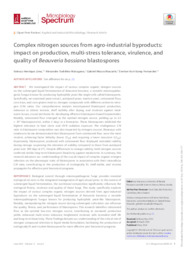Embrapa Environment
 Web Content Display
Web Content Display
Publications
 Busca de Publicações
Busca de Publicações
Complex nitrogen sources from agro-industrial byproducts: impact on production, multi-stress tolerance, virulence, and quality of Beauveria bassiana blastospores.
Author(s): LIMA, V. H.; MATUGAWA, A. T.; MASCARIN, G. M.; FERNANDES, É. K. K.
Summary: Abstract: We investigated the impact of various complex organic nitrogen sources on the submerged liquid fermentation of Beauveria bassiana, a versatile entomopatho genic fungus known for producing hydrophilic yeast-like single cells called blastospores. Specifically, we examined yeast extract, autolyzed yeast, inactive yeast, cottonseed flour, corn bran, and corn gluten meal as nitrogen compounds with different carbon-to-nitro gen (C:N) ratios. Our comprehensive analysis encompassed blastospore production, tolerance to abiotic stresses, shelf stability after drying, and virulence against meal worm larvae, crucial attributes for developing effective blastospore-based biopesticides. Notably, cottonseed flour emerged as the optimal nitrogen source, yielding up to 2.5 × 109 blastospores/mL within 3 days in a bioreactor. These blastospores exhibited the highest tolerance to heat stress and UV-B radiation exposure. The endogenous C:N ratio in blastospore composition was also impacted by nitrogen sources. Bioassays with mealworm larvae demonstrated that blastospores from cottonseed flour were the most virulent, achieving faster lethality (lower LT50) and requiring a lower inoculum (LC50). Importantly, blastospores produced with cottonseed flour displayed extended viability during storage, surpassing the retention of viability compared to those from autolyzed yeast over 180 days at 4°C. Despite differences in storage viability, both nitrogen sources conferred similar long-term blastospore bioactivity against mealworms. In summary, this research advances our understanding of the crucial impact of complex organic nitrogen selection on the phenotypic traits of blastospores in association with their intracellular C:N ratio, contributing to the production of ecologically fit, shelf-stable, and virulent propagules for effective pest biocontrol programs.
Publication year: 2024
Types of publication: Journal article
Unit: Embrapa Environment
